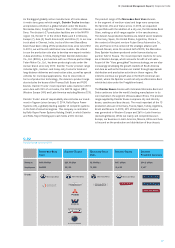Mercedes 2013 Annual Report Download - page 76
Download and view the complete annual report
Please find page 76 of the 2013 Mercedes annual report below. You can navigate through the pages in the report by either clicking on the pages listed below, or by using the keyword search tool below to find specific information within the annual report.
80
Net assets. Net assets represent the basis for the investors’
required return. The industrial divisions are accountable
for the net operating assets; all assets, liabilities and provisions
which they are responsible for in day-to-day operations are
therefore allocated to them. Performance measurement at
Daimler Financial Services is on an equity basis, in line with
the usual practice in the banking business. Net assets at Group
level include the net assets of the industrial divisions and
the equity of Daimler Financial Services, as well as assets and
liabilities from income taxes and other reconciliation items
which cannot be allocated to the divisions. Average annual net
assets are calculated from average quarterly net assets.
E see page 91
Cost of capital. The required rate of return on net assets
and hence the cost of capital is derived from the minimum
rates of return that investors expect on their invested capital.
The cost of capital of the Group and the industrial divisions
comprises the cost of equity as well as the costs of debt and
pension obligations of the industrial business; the expected
returns on liquidity and plan assets of the pension funds of the
industrial business are considered with the opposite sign.
The cost of equity is calculated according to the capital asset
pricing model (CAPM), using the interest rate for long-term
risk-free securities (such as German government bonds) plus
a risk premium reflecting the specific risks of an investment
in Daimler shares. While the cost of debt is derived from the
required rate of return for obligations entered into by the
Group with external lenders, the cost of capital for pension
obligations is calculated on the basis of discount rates used
in accordance with IFRS. The expected return on liquidity is
based on money market interest rates. The Group’s cost
of capital is the weighted average of the individually required
or expected rates of return; in the reporting period, the cost
of capital amounted to 8% after taxes. For the industrial divisions,
the cost of capital amounted to 12% before taxes; for Daimler
Financial Services, a cost of equity of 13% before taxes was
applied.
C.04
Return on sales. As one of the main factors influencing value
added, return on sales is of particular importance for asses-
sing the industrial divisions’ profitability. The combination
of return on sales and net assets’ productivity results in return
on net assets (RONA). If RONA exceeds the cost of capital,
value is created for our shareholders. The profitability measure
for Daimler Financial Services is not return on sales, but return
on equity, in line with the usual practice in the banking business.
Key performance indicators. Key financial indicators
for measuring our operating financial performance, in addition
to EBIT and revenue, are the free cash flow of the industrial
business, investment, and research and development expen-
diture. As well as the indicators of financial performance,
we also use various non-financial indicators for the Group’s
management. Of particular importance in this respect are
the unit sales of our automotive divisions, which we use as the
basis for our capacity and human resources planning, and
employee numbers.
Furthermore, within the context of our sustainability manage-
ment, we use other non-financial indicators such as the
CO2 emissions of our vehicle fleet or the energy and water
consumption of our production sites.
Details of the development of non-financial performance
indicators can be found in the chapters “Economic
Conditions and Business Development” and “Sustainability.”
E see pages 81 ff and 105 ff
Daimler strengthens customer focus
In order to implement the growth strategies in all divisions
and to sharpen the focus on customers and markets, the Board
of Management of Daimler AG decided in September 2013
to strengthen the organization of the divisions. Responsibility
for the main sales functions and the important sales markets
has been directly anchored in each division. At the same time,
we have streamlined the cross-divisional functions at the
country level. The functional Board of Management areas have
been focused more on the requirements of the divisions.
Following the successful start of product offensives for cars
and commercial vehicles, the further development of our
structures is now the next strategic step for the achievement
of our growth targets. This is not primarily a matter of cost
advantages, but of more direct customer relations and increa-
sed unit sales. Due to increasingly diverse customer needs,
more and more importance is now placed on the ability to pre-
cisely meet customers’ needs in each individual market.
With the new structure, Daimler is creating ideal conditions
to do that.
Corporate governance statement
The corporate governance statement to be issued pursuant
to Section 289a of the German Commercial Code (HGB)
can be seen on the Internet at w daimler.com/corpgov/en.
Pursuant to Section 317 Subsection 2 Sentence 3 of the
HGB, the contents of the statement pursuant to Section 289a
of the HGB are not included in the audit carried out by the
external auditors.
C.04
Cost of capital
2013 2012
In percent
Group, after taxes 88
Industrial business, before taxes 12 12
Daimler Financial Services, before taxes 13 13
























